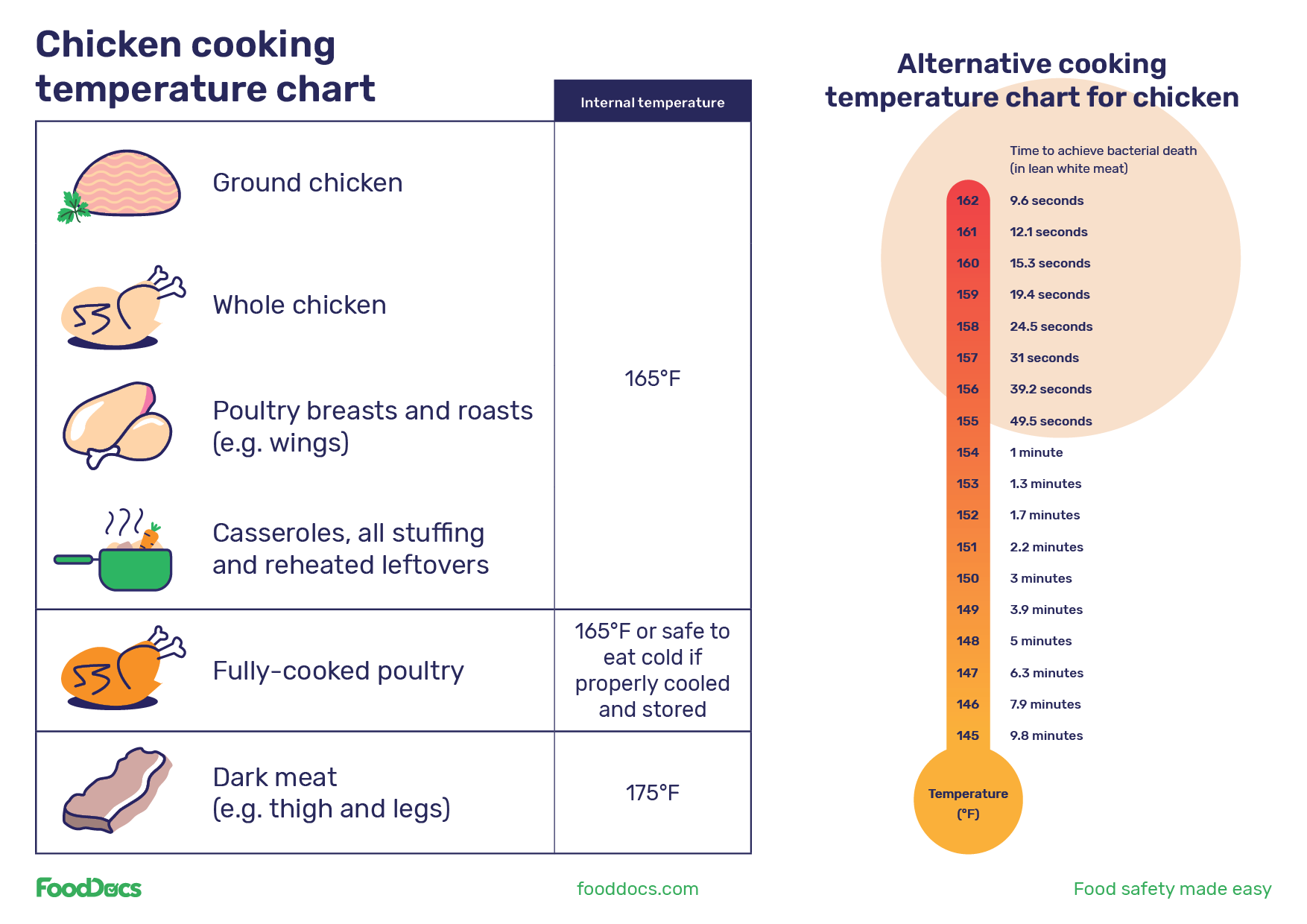It might seem hard to cook a whole chicken, but it’s actually pretty easy if you know what temperature to cook it to. If you cook your chicken to the right temperature, it will be moist, tender, and full of flavor. Keep reading to find out what temperature to cook whole chickens to and how to get perfect results every time.
The Magic Number: 165°F
The USDA recommends cooking all poultry, including whole chickens, to an internal temperature of 165°F. This temperature ensures any potentially harmful bacteria are killed, making the chicken safe to eat.
Make sure to put the instant-read meat thermometer into the thickest part of the thigh and not touch the bone when you check the temperature. When it reaches 165°F, you can be sure that the breasts and other parts of the chicken are also fully cooked. The thigh is the last partto finish cooking.
Some pieces of the chicken may have reached 165°F while others are still not quite there. Just move the fully cooked pieces to a platter and put the undercooked ones back in the oven for a little longer.
Why 165°F Makes for Ideal Chicken
Cooking chicken to 165°F yields several benefits:
-
Food safety: Salmonella and other pathogens are killed at 165°F, which lowers the risk of getting sick from food.
-
Juiciness – Chicken cooked to 165°F retains more moisture than chicken cooked to higher temps. The meat stays tender and succulent.
-
Appealing texture – 165°F strikes the right balance between succulent meat and crispy skin. The chicken won’t be rubbery or dry.
-
Fully opaque meat – Chicken cooked to 165°F will not have any traces of pink, blood-tinged meat, which can be unappetizing to some.
-
Ideal for all methods – Whether roasting, baking, grilling, or sautéing, 165°F ensures properly cooked chicken every time.
So for reliably delicious and safe chicken, 165°F is the go-to temperature to remember.
Tips for Cooking Whole Chicken to 165°F
Follow these tips and tricks to ensure your whole chicken reaches the ideal 165°F temperature:
-
Preheat oven fully before cooking. Starting with a hot oven helps chicken cook faster and more evenly.
-
Use an instant-read thermometer. Thermometers provide the most reliable way to test doneness. Try not to pierce chicken multiple times, to prevent losing juices.
-
Cook at 400°F or above initially. The high heat crisps the skin nicely. Lower heat to 350°F once browned.
-
Roast breast-side up, then flip. Place chicken breast-side up for the first 2/3 of cooking, then flip breast-side down for the last 1/3 to prevent overcooking.
-
Tent with foil if over-browning. If skin or drippings start burning, loosely tent foil over chicken to shield it.
-
Check temperature early. Test chicken’s temp about 30 mins before expected finish time. If under 165°F, return to oven.
-
Let rest before carving. Let chicken rest at least 10 minutes once removed from oven. Juices will redistribute and final temperature will rise a bit.
-
Check thick part of thigh. Be sure to insert thermometer into the innermost section of the thigh to get the most accurate reading.
-
Cook to higher temp if stuffing chicken. An unstuffed bird can be cooked to 165°F, but a stuffed chicken should reach 175°F in the thigh to account for the stuffing.
-
Use convection setting if available. The constant air circulation of convection ovens cooks chicken more evenly.
Follow these tips and your whole chicken will turn out perfectly cooked from the breast meat to the thighs each and every time. Happy roasting!

The Ina Garten Method
I have made Ina Garten’s roast chicken recipe many times. In fact, it was one of the first recipes I made for my husband when we were dating. I like it for its simplicity and delicious results, namely the flavorful meat and beautifully crispy, golden skin.
While I skip rinsing the chicken (due to the potential risks of cross-contamination), I otherwise stay true to the recipe as written. I choose a small bird, around four to five pounds, and roast it at her recommended 425°F, covering the breast with foil during the last bit of cooking if I notice its going from golden to dark brown.
Around the one-hour mark, I check the temperature of the thigh. If it’s 165°F, I pull it; if it’s less than that, I put it back in the oven for more roasting. It’s a near-perfect method with a few caveats.
What is the Safe Temperature to Cook Chicken to?
FAQ
Is whole chicken done at 165 or 180?
Simply insert your food thermometer into the thickest part of the chicken (for a whole chicken, that would be the breast). You know your chicken is cooked when the thermometer reads 180°F (82°C) for a whole chicken, or 165°F (74°C) for chicken cuts.
Is 180 too much for chicken?
➤ Chicken Thigh Temp, Leg Temp: 170°F and Higher Dark meat (leg and thigh meat) is still safe at 165°F, but it is recommended to cook it to an internal temperature of about 170-175°F (77-79°C). The chicken’s legs are actively worked muscles, and the meat is tougher because of it.
What temperature should a whole chicken be when it is fully cooked?
GrillingCutInternal TemperatureAverage Cooking Time*Ground chicken patties (120 g raw)165°F (74°C)6 minutes per sideWhole chicken – unstuffed (1. 5 kg raw)180°F (82°C)1 hour 25 minutesWings (90 g raw)165°F (74°C)8 minutes per side.
Is chicken overcooked at 170 degrees?
Chicken is done at 160 for white meat and 165 for dark. If it’s a bone-in breast, make sure the thermometer is in the meat and not touching a bone. If it’s boneless, it’s likely that it is overcooked, but eating it will be the best way to determine that.
